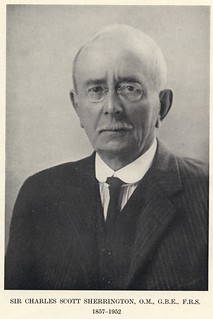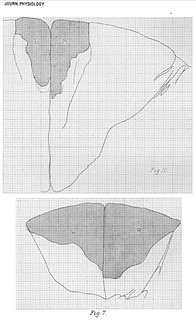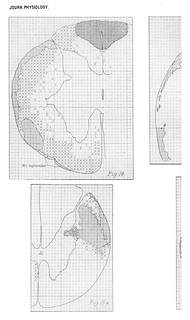- Creation
-
Creators (Definite): Sir Charles Scott Sherrington; The Cambridge Engraving CompanyDate: 1893
- Current Holder(s)
-
- No links match your filters. Clear Filters
-
Cited by
 C.S. Sherrington, 'Note on the Spinal portion of some Ascending Degenerations', Journal of Physiology 14 (4-5) (1893), pp. 255-302.
C.S. Sherrington, 'Note on the Spinal portion of some Ascending Degenerations', Journal of Physiology 14 (4-5) (1893), pp. 255-302.
Description:Figs. 18-22 in text:
'The diminution in the quantity of degeneration is well marked in Rhesus as already shown. In man in a cord the opportunity of preparing sections from which I owe to Dr Hadden, after complete destruction of the posterior columns near the level of the 6th thoracic root the ascending degeneration in the posterior column showed a similar continued diminution in passing along the cervical region. (Figs. 18, 19).
[table here enumerates proportions of degenerated columns]
In the Dog in result of complete transverse lesion at the level, of 9th thoracic root the ascending degeneration after 45 days gave the following measurements. (Figs. 20, 21.)
[table here enumerates proportions of degenerated columns]
The decrease in the area of degeneration is therefore marked in the dog, but apparently not so great as in Rhesus.' (284)
Fig. 19 in text:
'A comparison is interesting between this descending degeneration two segments below a transverse spinal lesion and the descending degeneration of the pyramidal tract at the same level resulting from ablation of the whole "cord region" of the cortex (except Schäfer and France's gyrus fornicatus area). Not only is the area of descending degeneration (Fig. 19) in the lateral column much more extended in the case of the spinal lesion than in that of the cortical (Fig. 17 A) but within the area itself the density of the degeneration is much greater. Commingled therefore with cerebial fibres descending from the "cord-region" of the cortex are, as well as ascending spinal fibres, fibres which descend and are probably of spinal, some possibly of cerebellar (Marchi) [note: 'Rivista Sperim. di Freniatria, 1888.'] origin, all of them contained within the field appropriated by nomenclature to the crossed pyramidal tract [note: 'Sherrington. This Journal, 1885.'].' (282)
Fig. 22 in text:
'In the experiment from which the above measurements were quoted the degeneration at the 6th thoracic root level measured between a quarter and a third of the whole column, instead of more than a half as in Rhesus. In an experiment in which the cord (Dog) was completely divided at the level of the 6th thoracic the condition of the cord three segments higher is seen in analysis in Fig. 22. By measurement it was found that
[table here enumerates proportions of degenerated columns]
i.e. less than a quarter instead of more than a half as in Expt. III. The degeneration had been allowed 52 days.' (285)
Fig. 24 in text:
'Weigert-Pal preparations. At the level of the 2nd thoracic root 49 squares were counted in the median posterior column of the right side and 323 in the column of the left side. The 49 squares contained 2317 nerve-fibres, the 323 squares 14891 nerve-fibres; the 49 right hand squares gave an average therefore of 47.2 nerve-fibres per square, the 323 an average of 46.1 per square. (Fig. 23.)
At the level of the 2nd cervical root 49 squares in approximately the same part of the column as the 49 taken at the 2nd thoracic root contained 2394 nerve-fibres, i.e. 488 fibres per square. In the other column, i.e. right hand, 196 squares were counted in a position more closely abutting upon the dorsal angle of the column and more closely hugging the median dorsal septum than the squares counted at the 2nd thoracic level, in order to allow for the kind of shifting of position to which the fibres in the column are subjected as revealed by the degenerations studied above. (Fig. 24.) In the 196 squares 9724 fibres were found, giving an average of 49.6 to the square. The condensation found therefore would account for a diminution in size of the area of absolute degeneration of about 8 p.c.' (288)














